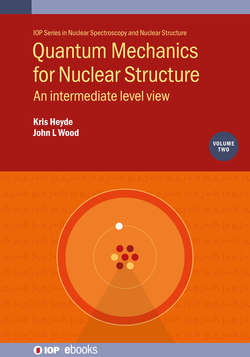Читать книгу Quantum Mechanics for Nuclear Structure, Volume 2 - Professor Kris Heyde - Страница 27
На сайте Литреса книга снята с продажи.
1.18 Coherent states for SU(2)
ОглавлениеThe generalisation of the coherent state concept from the one-dimensional harmonic oscillator (Volume 1, section 5.5) to angular momentum is effected through their respective algebras: the Heisenberg–Weyl algebra in one dimension, hw(1) and su(2).
| hw(1) | su(2) | |
| Generators | a† | J+ |
| a | J− | |
| I | J 0 | |
| Commutator relations | [a,a†]=I | [J−,J+]=−2J0 |
| [I,a†]=0 | [J0,J+]=+J+ | |
| [I,a]=0 | [J0,J−]=−J− | |
| Lowest-weight state | ∣0〉 | ∣j,−j〉≔∣−j〉 |
| a∣0〉=0 | J−∣−j〉=0 |
Generalising the type-I coherent state from HW(1) to SU(2)
∣ζI〉≔expζ*J+−ζJ−∣−j〉,(1.289)
for ζ≔12θeiϕ,
eζ*J+−ζJ−=e−iθ(Jxsinϕ−Jycosϕ)=e−iθ(J⃗·nˆ),(1.290)
where nˆ is a unit vector in the x,y plane making an angle ϕ with the negative y-axis. This is illustrated in figure 1.5. All physically significant rotations are accommodated by this formalism (the apparent exclusion of rotations about the z-axis only excludes changes in phase, which could be introduced using e−iχJ0).
Figure 1.5. A depiction of the parameters ϕ and θ that define a type-I SU(2) coherent state.
The state ∣ζ〉I, ζ=ζ(θ,ϕ), can be expressed:
∣ζ〉I=∣θ,ϕ〉I=e−iθ(J⃗·nˆ)∣j,−j〉=∑m∣jm〉〈jm∣e−iθ(J⃗·nˆ)∣j,−j〉=∑m∣jm〉Dm,−j(j)(ϕ,θ,0)*.(1.291)
From the orthonormality of the D functions, sections 1.11 and 1.12,
I=(2j+1)4π∫dΩ∣θ,ϕ〉II〈θ,ϕ∣,dΩ=sinθdθdϕ.(1.292)
The states exp{ζ*J+−ζJ−}∣j,−j〉 are sometimes called ‘atomic coherent’ or ‘Bloch’ states (see, e.g. [4]).
The type-II coherent states of HW(1) can be generalised to SU(2):
∣z〉II≔exp(z*J+)∣j,−j〉.(1.293)
(∣ζ〉I and ∣z〉II are no longer trivially related, hence the use of z and ζ.)
The SU(2) states can be expressed in terms of the ∣z〉II:
∣Ψ〉→Ψ(z)=II〈z∣Ψ〉=〈−j∣ezJ−∣Ψ〉≔Ψj(z).(1.294)
Operators are mapped into z-space realisations, Γ(O) by
O∣Ψ〉→Γ(O)ΨJ(z)=〈z∣O∣Ψ〉=〈−j∣ezJ−O∣Ψ〉=〈−j∣(ezJ−Oe−zJ−)ezJ−∣Ψ〉=〈−j∣(O+[zJ−,O]+12[zJ−,[zJ−,O]]+⋯)ezJ−∣Ψ〉.(1.295)
Essentially all operators of relevance can be expressed in terms of J−, J0, and J+, whence: for O=J−
and from ∂∂z(ezJ−)=J−ezJ−
⇒Γ(J−)=∂∂z.(1.297)
For O=J0
and from z∂∂z(ezJ−)=zJ−ezJ−
⇒Γ(J0)=−j+z∂∂z.(1.299)
For O=J+
⇒Γ(J+)=2jz−z2∂∂z.(1.301)
Then
Γ(J0)znn!=(−j+n)znn!,n=0,1,2,…,(1.302)
Γ(J+)znn!=(2j−n)zn+1n!=(2j−n)n+1zn+1(n+1)!,(1.303)
Γ(J−)znn!=nzn−1n!=nzn−1(n−1)!.(1.304)
